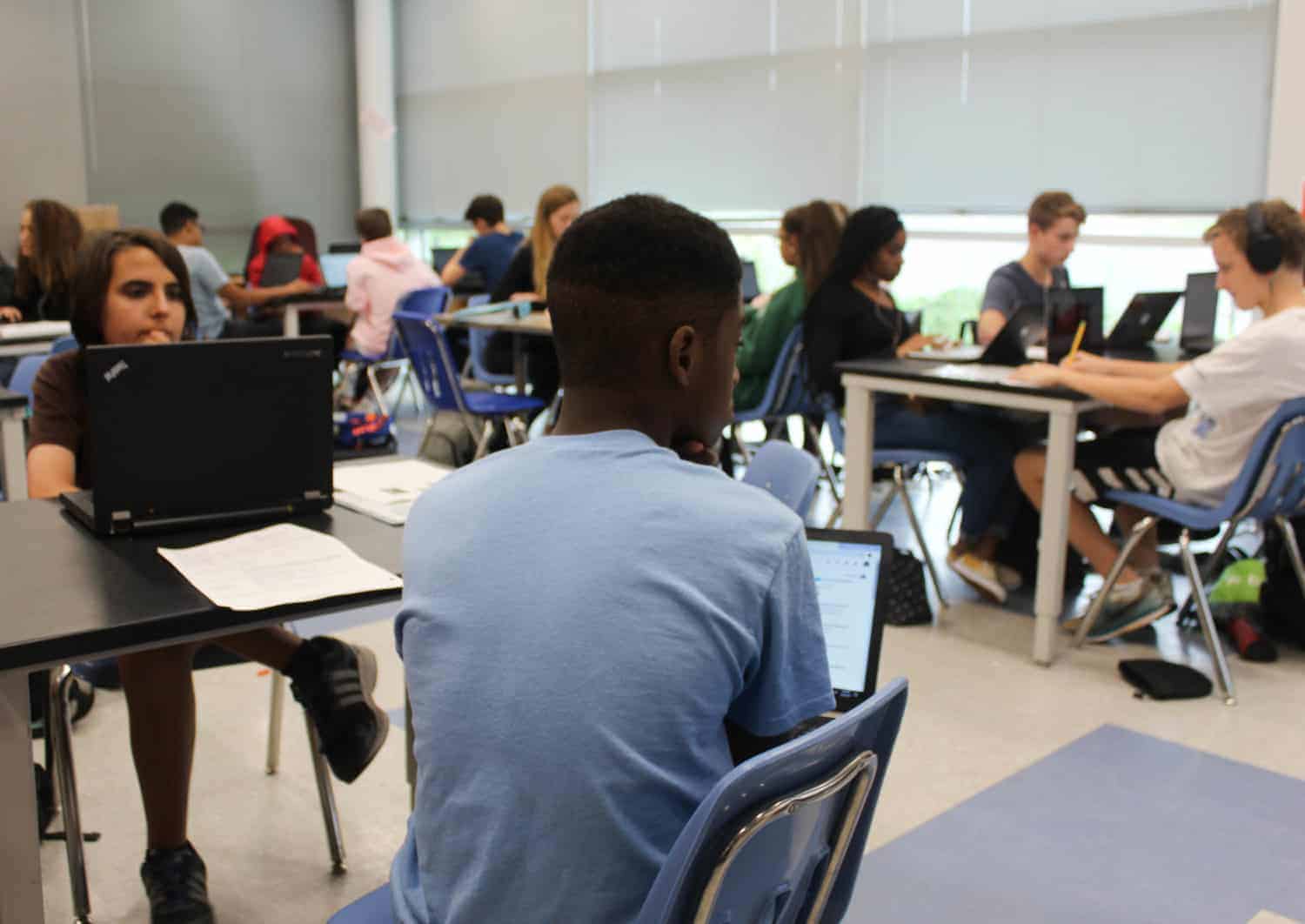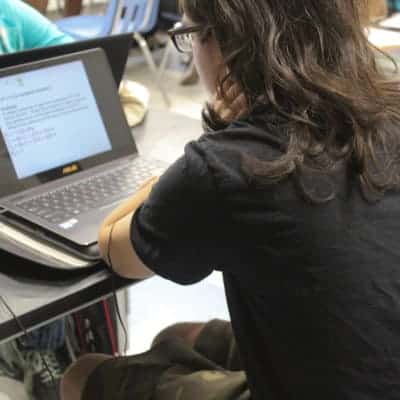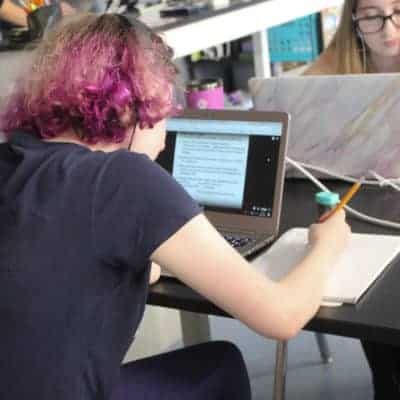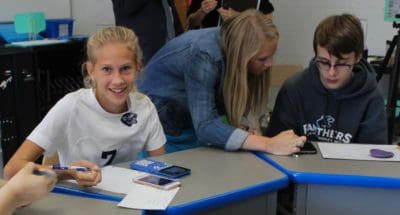“Every kid loves screen time,” says Amy Tart, a fifth grade English language arts teacher at Union Intermediate School in Clinton. Sampson County’s 2018-19 Teacher of the Year, Tart views the screen as a powerful tool for engagement. But she is savvy and strategic in her use of it. Tart leverages screens to grow global awareness in her students, whose opportunities to see the world are limited: 90 percent of Union Intermediate’s students live below the poverty line.
“A lot of my kids have never been out of the county, have never seen the ocean,” Tart says.
Virtually, they’re venturing across the ocean — and back in time. For two years, Tart has introduced her students, via Skype, to Simone Liebster, a French Holocaust survivor. No ordinary video chat, this conversation involves three months of preparation, as students read novels and study the Holocaust. A Jehovah’s Witness forced into a re-education camp, Liebster “doesn’t speak about her faith as much as, ‘Whatever you believe in, believe in it and never break away from it,’” says Tart. Impacts are palpable, powerful: “The kids are usually in tears afterwards.”
Tart also uses “Mystery Skype” to connect her students with a classroom in an undisclosed location. Yes or no questions, such as ‘Do you live below the Mason-Dixon Line?’ help her students locate virtual classmates. This game “increases their global awareness and helps with their geography skills,” says Tart.
A self-described “huge fan” of digital learning, Tart links strategic use of digital tools to academic gains. The first year she used Quizlet Live for vocabulary, her students finished in the top 10 percent in growth statewide. But Tart is clear that classroom management and culture must be a match for technology.
What does that mean? Technology use is thoughtful and targeted, and classroom interactions are marked by restraint and respect. During the first two weeks of the year, Tart didn’t allow her students to touch a computer. She addresses them as scholars and expects them to act that way.
“When they want to answer a question, they have to stand,” she says. “When I’m speaking, they have to be tracking me.”
Kids and screen time totals
Tart’s screen savvy is yielding big dividends for her students. Her approach affirms there’s a time to use digital tools — and a time to set them aside. As life becomes more digitalized, however, this determination feels increasingly difficult. Many educators thus find themselves on the horns of a dilemma.
In a 2018 Education Week survey of principals, 57 percent viewed digital technologies as an “important supplemental resource” for personalizing learning; another 16 percent said they were central to the school’s mission. Yet 85 percent expressed concern that technologies would contribute to excess screen time for students. Ninety-five percent believed students spent too much time at home with screens.
Parents are anxious, too. Nearly two-thirds worry their child gets too much screen time, according to 2018 survey data from Pew Research Center.
What do kids’ screen time totals look like? They’re high and climbing. According to Common Sense Media, children eight and under spend almost 2.5 hours daily with screen media. Tweens, ages eight to 12, average 4.5 hours daily with screen media, while teens, ages 13 to 18, spend nearly seven hours a day. These totals include recreational screen time only, not time spent with screens for schoolwork or homework.
Steady increases in screen time have been driven by access to mobile devices. Ownership is trending ever younger. The average age for a child’s first smartphone is 10. Among teens, 95 percent own or have access to a smartphone, according to Pew Research Center.
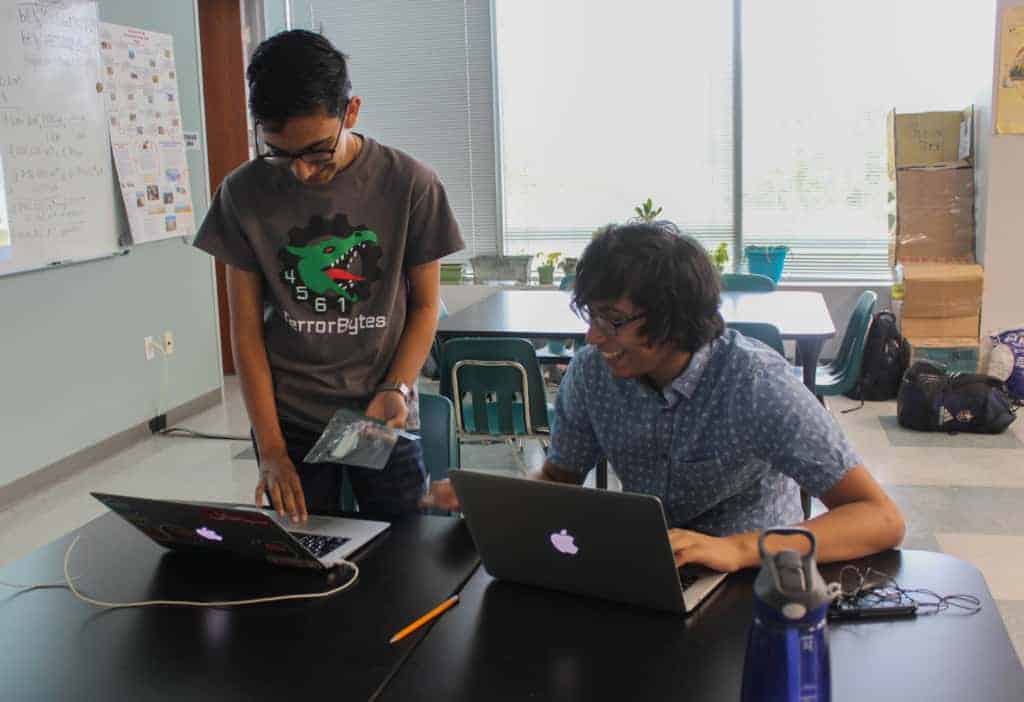

Screen time, children’s brains, and development
What’s the long-term impact of all this screen time? Effects are unknown — but that will change. The National Institutes of Health recently launched the Adolescent Brain Cognitive Development (ABCD) Study, described as “the largest long-term study of brain development and child health in the United States.” The goal, according to Dr. Lindsay Squeglia, a clinical psychologist and an ABCD principal investigator, is to enroll 11,900 children.
Squeglia, who co-chairs ABCD’s Mobile Technologies Working Group, says the study came together after cannabis was being legalized across the U.S. The National Institutes on Drug Abuse, ABCD’s main funder, wanted to learn about the effect of cannabis on adolescent brains.
“Once we started talking about the scope of the study,” Squeglia says, “a lot of other institutes got on board. The scope really changed to become huge,” extending beyond substance use to include sleep, screen time, and more. The new question became: How does the adolescent brain develop, and what kind of impact do these things have on development?
“It is really an interesting question that we are uniquely positioned to answer within the ABCD cohort,” says Squeglia.
Researchers will track children aged 9.00 to 10.99 years for more than a decade, says Squeglia. They’ll evaluate kids’ physical and mental health, neuro-cognition, substance use, and family environment; every two years, kids will undergo imaging scans assessing brain structure and function.
Researchers are taking a holistic approach to screen time, says Squeglia, targeting numerous variables and collecting data on kids’ cumulative weekday and weekend media consumption. Screen time encompasses recreational media only, not time spent with screens for school or homework.
Researchers aren’t just tracking quantity and frequency, Squeglia says, but also the platforms kids use: “What are they spending most of their time on? We are breaking it down by what kind of screen time it is — streaming TV or movies, YouTube, single player or multiplayer (video games), texting, apps, video chat, social media sites,” says Squeglia. Researchers want to know how attached kids are to their devices, and how screens impact daily life. Do kids feel distress when separated from phones? Have they tried to reduce use but couldn’t? Do they use media in bed before sleep?
“Personalization balance” for kids and screens
What do physicians recommend for families right now? In 2016, the American Academy of Pediatrics (AAP) released media guidelines tailored to children’s stage of development. For children younger than 18-24 months, the AAP recommends avoiding all screen media except video chatting. Preschoolers should limit screen time to one hour daily.
For school-aged children and adolescents, the AAP advocates “personalization balance.” Does screen time still matter? Pediatrician Dr. David Hill, chair of the AAP’s Council on Communications and Media, says, “Screen time matters inasmuch as it displaces other healthier activities. Screen time when you should be asleep matters. Screen time when you should be playing matters … Screen time that keeps children from talking to their parents, and sharing with their parents, matters. Is there a magic hour in screen time? To some extent, you need to look at the rest of the day.”
“This is a really tough challenge for families, teachers,” says pediatrician Dr. Kathleen Clarke-Pearson, a former member of AAP’s Council on Communications and Media and board member of the Children’s Screen Time Action Network. At the same time, notes Clarke-Pearson, screens are “really eating into family life.” When screens are used excessively, the “displacement of other things” becomes a major concern, she says. “The screen is a substitute for all kinds of activities that help a child or a teenager grow more freely.”
Dilemmas for families and schools
To help parents make wise choices, AAP has developed an online Family Media Plan. Undergirding the plan, Clarke-Pearson says, is the idea of getting the family to sit down together and ask, “How can we move forward and not be so digitalized?” Greater adaptability is coming: AAP’s media plan is getting an overhaul, says Clarke-Pearson.
For educators, are there evidence-based guidelines to help resolve dilemmas around balancing benefits of digital tools with concerns over screen time?
“I wish that there were,” says Hill. “At this time, the evidence for the positive and negative effects for the use of digital technology in teaching is still fairly immature. The American Academy of Pediatrics has been asked several times to develop a statement on this subject. There is not enough high-quality evidence to make a strong statement.”
For now, the way forward is “to treat this the way we’re treating all other screens — (ask) what is it doing?” says Hill. He points to myriad benefits from technologies, including opportunities to collaborate, provide personal scaffolding, and enable remote learning through online courses. “We definitely do not want to throw the baby out with the bathwater and say that because something occurs on a screen, it’s negative,” says Hill.
However, schools implementing technology without a strategic plan reap only marginal benefits, he adds. “The first question with any technology is, ‘Why do I need this? What’s it going to do for us?’ You have to start, as with any innovation, with a set of strategic goals.”
Tart understands strategic goals. “You can’t just throw a computer in the classroom,” she says. “It has to be a cohesive part. That’s what a lot of teachers struggle with — establishing good culture.”
